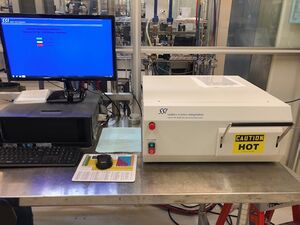Rapid Thermal Processor (SSI Solaris 150): Difference between revisions
No edit summary |
Text replacement - "www.nanotech.ucsb.edu/wiki/" to "wiki.nanotech.ucsb.edu/wiki/" |
||
| Line 38: | Line 38: | ||
*[[SSI Solaris 150 - Operating Procedure|Solaris 150 Operating Procedure]] |
*[[SSI Solaris 150 - Operating Procedure|Solaris 150 Operating Procedure]] |
||
*[https:// |
*[https://wiki.nanotech.ucsb.edu/wiki/images/6/66/Solaris_150_install_manual_software3_0_revQ.pdf User manual] |
||
Revision as of 01:28, 7 April 2020
| |||||||||||||||||||||||
About
The Solaris 150 is a manual loading RTP system for R&D and pre-production. The Solaris 150 can process up to 152.4mm substrates at a temperature range from RT- 1250 degrees. The unique temperature measurement system of the Solaris requires virtually no calibration for different wafer types and backside emmissivity differences.
The Solaris uses a unique PID process controller that ensures accurate temperature stability and uniformity. The system can accommodate four interlocked MFCs for gas mixing and forming gas processing. The Solaris is designed for silicon implant annealing and monitoring and compound semiconductor implant activation and ohmic alloying.
Detailed Specificiations
Wafer handling: Manual loading of wafer into the oven, single wafer processing.
Wafer sizes: 2", 3", 4", 5" and 6" wafers and pieces.
Ramp up rate: 10-200C per second, user-controllable.
Recommended steady state duration: 0-600 seconds per step.
Ramp down rate: Temperature Dependent, max 150°C per second.
Recommended steady state temperature range: 300C - 1250°C
Thermocouple temperature accuracy: + 2.5C
Temperature repeatability: + 3C or better at 1150C wafer-to-wafer.
Temperature uniformity: + 5C across a 6" (150 mm) wafer at 1150C.
